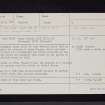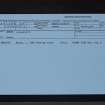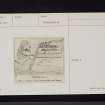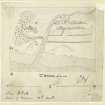Pricing Change
New pricing for orders of material from this site will come into place shortly. Charges for supply of digital images, digitisation on demand, prints and licensing will be altered.
Annan, Graveyard, Tower
Tower House (Medieval)
Site Name Annan, Graveyard, Tower
Classification Tower House (Medieval)
Alternative Name(s) 'Annan Castle'; Annan, Old Kirkyard
Canmore ID 66469
Site Number NY16NE 20
NGR NY 1920 6661
Datum OSGB36 - NGR
Permalink http://canmore.org.uk/site/66469
- Council Dumfries And Galloway
- Parish Annan
- Former Region Dumfries And Galloway
- Former District Annandale And Eskdale
- Former County Dumfries-shire
NY16NE 20 1920 6661
See also NY16NE 82.
(NY 1920 6661) Annan Castle (NR) (Site of) Graveyard (NAT) (Disused)
OS 25" map (1931)
A defensive tower built by Lord Herries about 1565 to replace the steeple of Annan Church, which had been maintained as a stronghold and which consisted of one storey above the basement when razed to the ground by an English force in 1547. As early as 1299, Edward I used the steeple as a victual store against possible attack by Robert Bruce. A map of c 1560 appears to confirm the site within the disused graveyard.
RCAHMS 1920
No trace of this tower was found.
Visited by OS (RDL) 27 February 1963
Publication Account (1981)
The castle of Annan has ancient origins. It is first mentioned in the c.1124 grant of David I to Robert Bruce of the lands of Annandale and its castle (ESC, 1905, 49). During the Wars of Independence, the castle reputedly stood in ruins (Miller, 1887-8, 241). Shortly after his coronation at Scone in 1332, the pretender Edward Balliol seized Annan castle and from there demanded the homage of Scots nobles. His triumph was short-lived. Under the silence of night the Earl of Douglas and a group of retainers swept down on the structure and captured it. In the fray Edward Balliol escaped, but his brother Henry was killed. The reporter in the New Statistical Account noted that the ruins of Annan Castle with the exception of a part of the wall built into the town house 'finally disappeared about forty years ago' (1841, 184). It is unknown when the castle ceased to function.
An alleged fragment of the castle of Annan which has caused some controversy is incorporated in the fabric of the burgh hall. Because of the date on the stone '1300', many local historians have assumed that the castle was rebuilt at this period. However, because of the Wars of Independence and the supposed English occupation of the area, this is unlikely. Furthermore the Investigators of the Royal Commission on Ancient Monuments observed that the 1 1300 1 date was not original, but the Lombardic lettering (which spells out the name and title of Robert Bruce) 'could only have been not earlier than 1292 nor later than 1296 1 (1920, 3).
Information from ‘Historic Annan: The Archaeological Implications of Development’, (1981).
Reference (1997)
NY16NE 20 1920 6661
Listed as tower.
RCAHMS 1997.














